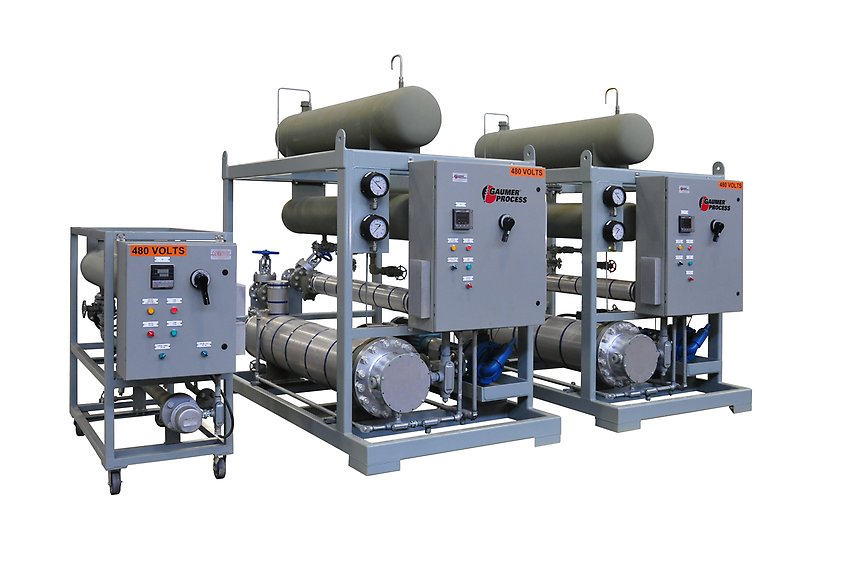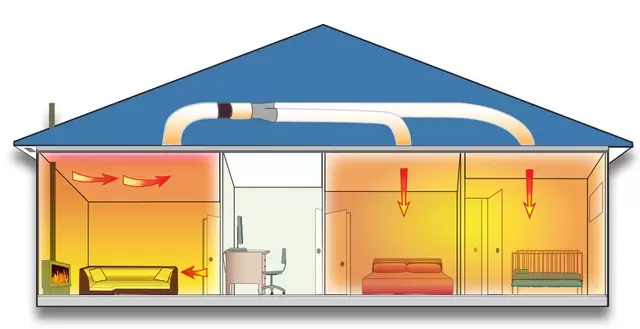Benefits of Choosing DVS Heat Transfer Systems for Compact Heat Exchanger Designs
Wiki Article
Innovations in Heat Transfer Solutions: What You Need to Know for Optimum Performance
Innovations in Heat transfer systems are transforming efficiency throughout different sectors. Advanced products like graphene and nanofluids guarantee considerable renovations in thermal conductivity. Meanwhile, the integration of IoT and machine knowing supplies possibilities for real-time monitoring and improved power effectiveness. The landscape of thermal monitoring is rapidly evolving. Understanding these developments is important for achieving suitable system performance and sustainability in the future. What details advancements are shaping this improvement?Arising Products for Enhanced Heat Transfer

Advanced Heat Exchanger Designs
While standard Heat exchangers have actually served their objective in different applications, advanced designs are currently emerging to fulfill the increasing demands for effectiveness and efficiency. These cutting-edge styles, such as plate, shell-and-tube, and finned-tube Heat exchangers, include improved surface locations and enhanced flow patterns to raise thermal transfer rates. Additionally, compact designs permit minimized space needs without jeopardizing efficiency. Advanced materials, such as composites and corrosion-resistant alloys, furthermore enhance toughness and efficiency under severe conditions. Simulation modern technologies and computational liquid dynamics are progressively used to fine-tune these styles, making sure peak Heat transfer characteristics. As markets look for to lessen energy consumption and optimize output, the adoption of innovative Heat exchanger styles is essential in accomplishing these goals.The Role of Nanotechnology in Heat Transfer
Nanotechnology plays an important duty in improving thermal conductivity within Heat transfer systems. By controling products at the nanoscale, scientists have actually attained substantial enhancements in energy efficiency. These improvements not just maximize efficiency yet additionally contribute to even more lasting energy options.Enhanced Thermal Conductivity
Considerable innovations in thermal conductivity have emerged with the application of nanotechnology, revolutionizing Heat transfer systems throughout different sectors. By including nanoparticles into Heat transfer fluids and materials, researchers have attained remarkable rises in thermal conductivity. These nanoparticles, such as carbon nanotubes, graphene, and steel oxides, improve the Heat transfer residential properties because of their high surface and special thermal characteristics. The resulting composites exhibit enhanced performance in applications varying from electronics cooling down systems to renewable resource modern technologies. The capacity to customize the size, shape, and make-up of nanoparticles allows for enhanced thermal monitoring services. Because of this, nanotechnology continues to play a pivotal role in the advancement of a lot more reliable and efficient Heat transfer systems, paving the method for enhanced industrial applications.
Power Efficiency Improvements

Assimilation of IoT in Heat Transfer Systems
The combination of IoT in Heat transfer systems introduces the execution of smart sensors that improve operational effectiveness. These sensors allow real-time information tracking, allowing for prompt changes and optimizations. This technological development has the potential to significantly boost performance and energy monitoring in Heat transfer applications.Smart Sensors Execution
As Heat transfer systems advance, the assimilation of clever sensing units through the Web of Things (IoT) has actually emerged as a transformative technique. These sensing units allow real-time surveillance of stress, temperature, and circulation prices, boosting system performance and dependability. By gathering and transferring information, they help with positive maintenance, decreasing the danger of system failings. Additionally, clever sensors contribute to power financial savings by refining operational parameters based on ecological problems. Their ability to evaluate anomalies and trends permits notified decision-making, guaranteeing peak efficiency of Heat transfer systems. As markets increasingly embrace this innovation, the implementation of clever sensors stands to revolutionize exactly how Heat transfer systems are managed, leading the way for better sustainability and boosted efficiency end results.Real-Time Data Monitoring
How can real-time data checking enhance the effectiveness of Heat transfer systems? By integrating Internet of Things (IoT) technology, Heat transfer systems can leverage constant data collection from wise sensors. This real-time monitoring permits immediate evaluation of pressure, temperature check this site out level, and flow prices, enabling operators to recognize inadequacies promptly. Modifications can be made to maximize efficiency, reduce power consumption, and extend equipment life-span. In addition, predictive maintenance can be carried out, decreasing unforeseen downtime and expensive fixings. The ability to picture performance metrics with dashboards boosts decision-making, fostering a proactive technique to system monitoring. Ultimately, real-time data checking not only boosts operational effectiveness however additionally adds to sustainability goals within commercial procedures.Energy Performance and Sustainability Trends
Energy performance and sustainability patterns are reshaping the landscape of Heat transfer systems, driving technology and conformity across various sectors. Organizations are progressively focusing on energy-efficient layouts to minimize functional costs and minimize ecological impacts. The combination of renewable resource resources is coming to be much more prevalent, allowing Heat transfer systems to run sustainably while meeting regulatory demands. Furthermore, improvements in products and innovations advertise reduced energy consumption and boost overall efficiency. Lifecycle analyses are likewise gaining traction, allowing companies to review the environmental impact of Heat transfer systems from production to disposal. This emphasis on sustainability not just supports business responsibility yet likewise positions organizations competitively in a market where customers increasingly prefer eco-friendly solutions. Energy efficiency and sustainability stay critical factors to consider for future growths in Heat transfer innovation.Innovations in Thermal Monitoring Solutions
While the demand for reliable Heat transfer continues to increase, advancements in thermal management services are arising to deal with both performance and sustainability difficulties. Advanced materials, such as stage modification products and nanofluids, are being developed to improve Heat transfer effectiveness look at this site - DVS Heat Transfer Systems. These materials enhance thermal conductivity and enable far better temperature level policy in different applications. In addition, innovations like active thermal control systems are getting grip, making it possible for real-time adjustments to handle Heat circulation efficiently. These systems add to energy savings and decrease the environmental effect of thermal processes. Furthermore, the assimilation of IoT in thermal monitoring promotes surveillance and predictive maintenance, making sure enhanced efficiency and long life of Heat transfer systems. Overall, these developments stand for considerable strides towards more lasting thermal monitoring techniquesFuture Directions in Heat Transfer Modern Technology
Emerging improvements in thermal monitoring remedies indicate a promising future for Heat transfer modern technology. Researchers are progressively focusing on establishing materials with remarkable thermal conductivity and improved power performance. Innovations such as nanofluids, which include put on hold nanoparticles, offer significant renovations in Heat transfer efficiency. Furthermore, the assimilation of smart products that adapt to varying temperature level conditions is acquiring traction, permitting even more responsive and effective systems. The rise of additive manufacturing techniques is additionally enabling the style of complex Heat exchanger geometries that maximize fluid circulation. The execution of maker discovering algorithms is anticipated to revolutionize the optimization of Heat transfer systems, helping with predictive maintenance and efficiency enhancement. Collectively, these developments are poised to change the landscape of Heat transfer modern technologies in different industries.
Frequently Asked Concerns

How Do I Select the Right Heat Transfer System for My Application?
Selecting the right Heat transfer system involves assessing application requirements, including temperature ranges, fluid residential or commercial find out here now properties, and effectiveness requirements. Evaluating system kinds, upkeep factors to consider, and cost-effectiveness additionally plays a vital duty in making an educated choice.What Are the Maintenance Requirements for Advanced Heat Exchangers?
Upkeep demands for innovative Heat exchangers typically consist of normal evaluations, keeping an eye on for leaks, cleansing of surfaces, and assuring optimal circulation rates. Sticking to supplier standards warranties effective procedure and lengthens the equipment's life-span.
Just How Do Ecological Factors Affect Heat Transfer Effectiveness?
Ecological factors significantly affect Heat transfer performance. Variations in temperature, airflow, and humidity influence thermal conductivity and convective Heat transfer, inevitably influencing system performance and necessitating consideration during the design and operation of Heat transfer systems.What Safety Criteria Put On Heat Transfer Equipments?
Security standards for Heat transfer systems commonly consist of standards from companies such as ASME and ASTM. DVS Heat Transfer Systems. These standards address materials, style, and functional practices to ensure reliability, performance, and security against hazards in various applications
Just How Can I Repair Usual Heat Transfer System Issues?
Fixing usual Heat transfer system concerns entails looking for leakages, ensuring correct fluid flow, inspecting insulation honesty, and confirming temperature differentials. Identifying these factors can help preserve system performance and stop additional problems.Nanotechnology plays an important function in improving thermal conductivity within Heat transfer systems. Substantial developments in thermal conductivity have emerged with the application of nanotechnology, changing Heat transfer systems across different sectors. Advancements in thermal conductivity via nanotechnology have actually led the method for impressive renovations in energy performance within Heat transfer systems. Power effectiveness and sustainability patterns are reshaping the landscape of Heat transfer systems, driving development and conformity throughout various industries. The assimilation of IoT in thermal administration facilitates surveillance and anticipating upkeep, making certain optimized efficiency and longevity of Heat transfer systems.
Report this wiki page